HI5017, T2 2019: Management Accounting System Report Analysis
VerifiedAdded on 2022/10/09
|15
|4026
|21
Report
AI Summary
This report critically evaluates an article by Watts et al. (2014) on the implementation of a Management Accounting System (MAS) in a manufacturing firm, answering four key questions regarding MAS's role and information provision. The report identifies examples of MAS methods, such as BSC, ABC, and TQM, assessing their relevance to contemporary organizations based on the case study and comparing findings with another journal article by Yigitbasioglu (2016). It determines whether the findings align or differ, providing example-based explanations. The conclusion emphasizes MAS's relevance in a competitive business environment. Finally, the report extracts four key lessons from both articles useful for management accountants in Australian companies, with justifications, covering outcomes from each article. The report also highlights the types of MAS methods/techniques, their relevance in contemporary organizations, and offers a conclusion on MAS's relevance in uncertain and competitive business environments, drawing upon insights from the two articles to provide a comprehensive understanding of the subject.
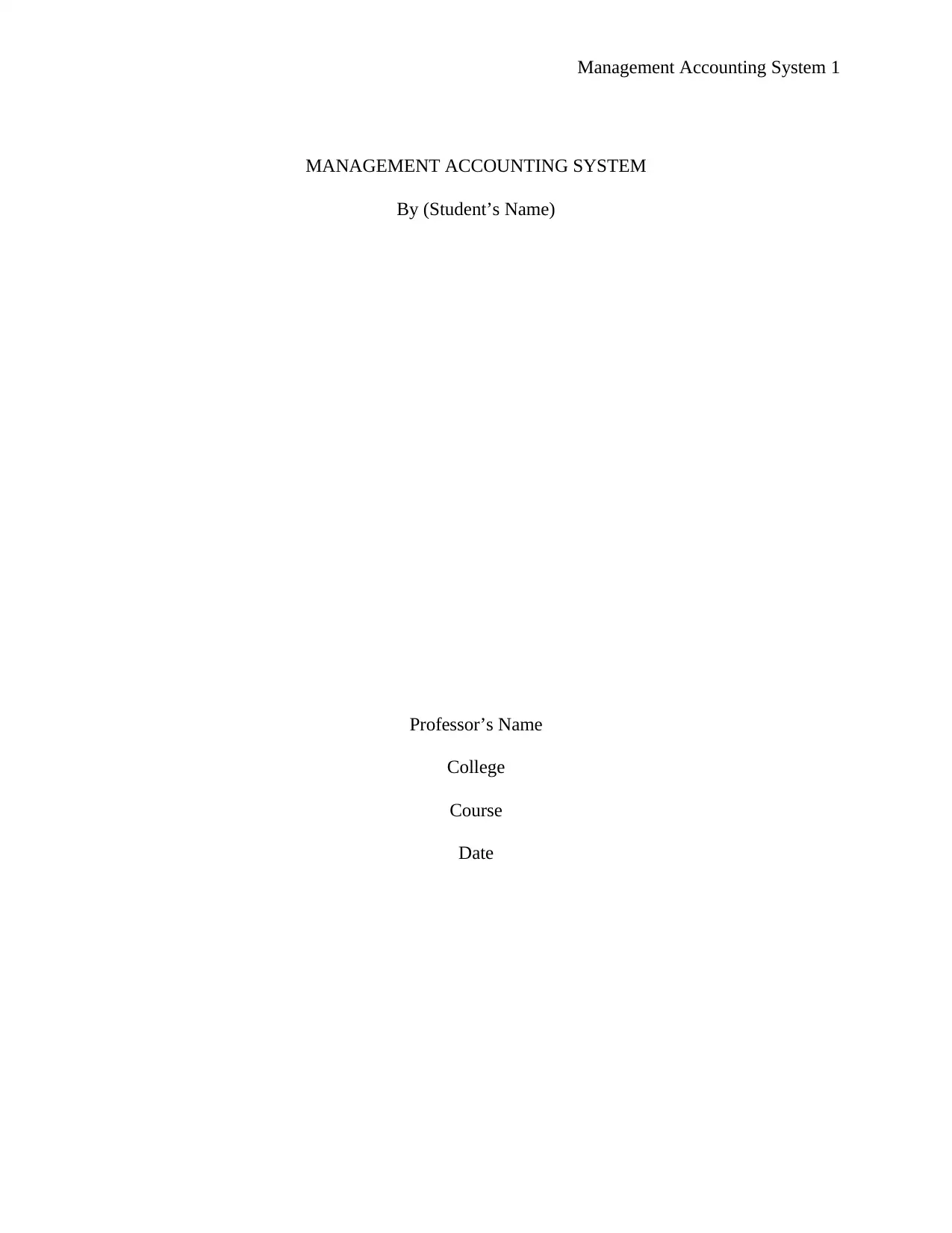
Management Accounting System 1
MANAGEMENT ACCOUNTING SYSTEM
By (Student’s Name)
Professor’s Name
College
Course
Date
MANAGEMENT ACCOUNTING SYSTEM
By (Student’s Name)
Professor’s Name
College
Course
Date
Paraphrase This Document
Need a fresh take? Get an instant paraphrase of this document with our AI Paraphraser
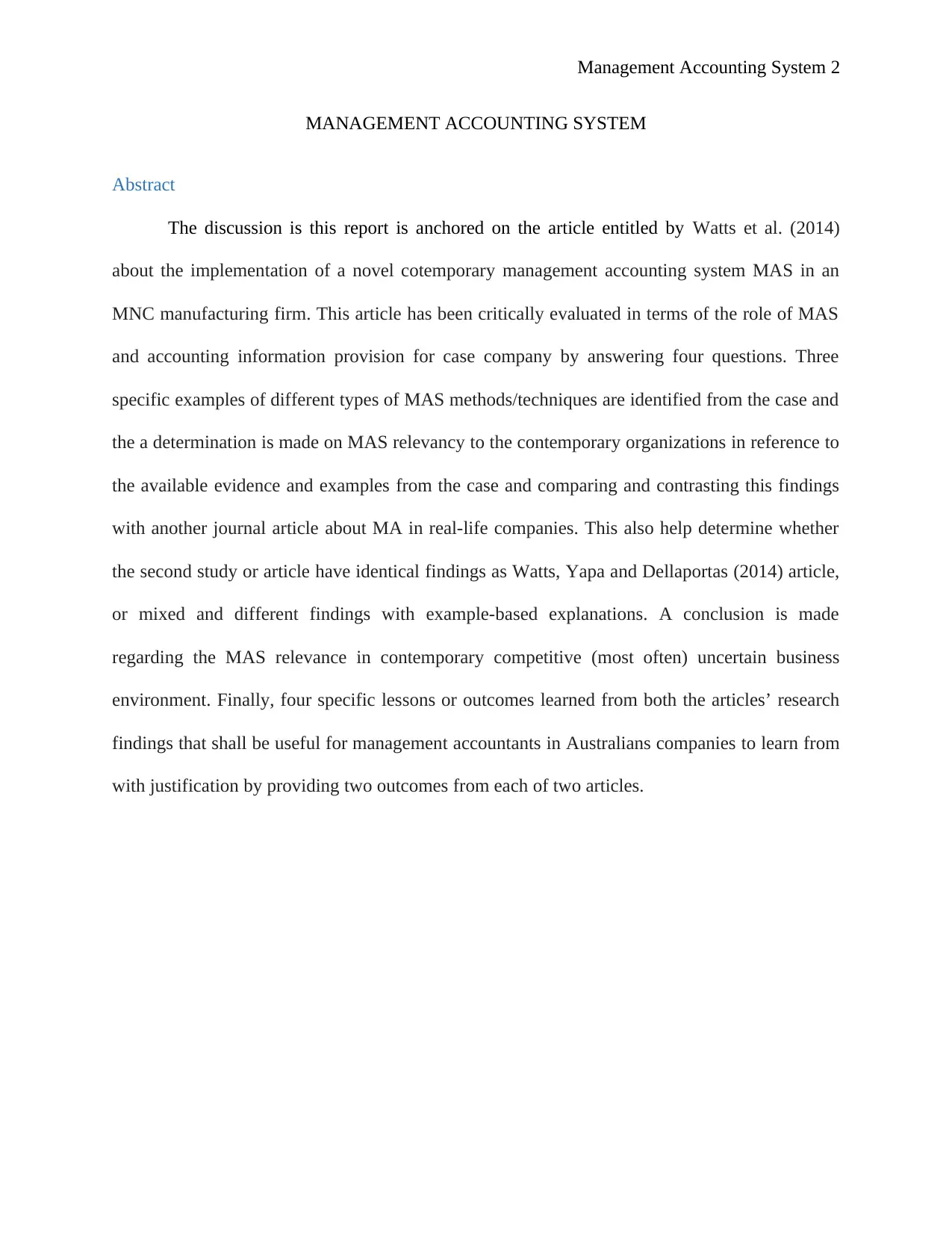
Management Accounting System 2
MANAGEMENT ACCOUNTING SYSTEM
Abstract
The discussion is this report is anchored on the article entitled by Watts et al. (2014)
about the implementation of a novel cotemporary management accounting system MAS in an
MNC manufacturing firm. This article has been critically evaluated in terms of the role of MAS
and accounting information provision for case company by answering four questions. Three
specific examples of different types of MAS methods/techniques are identified from the case and
the a determination is made on MAS relevancy to the contemporary organizations in reference to
the available evidence and examples from the case and comparing and contrasting this findings
with another journal article about MA in real-life companies. This also help determine whether
the second study or article have identical findings as Watts, Yapa and Dellaportas (2014) article,
or mixed and different findings with example-based explanations. A conclusion is made
regarding the MAS relevance in contemporary competitive (most often) uncertain business
environment. Finally, four specific lessons or outcomes learned from both the articles’ research
findings that shall be useful for management accountants in Australians companies to learn from
with justification by providing two outcomes from each of two articles.
MANAGEMENT ACCOUNTING SYSTEM
Abstract
The discussion is this report is anchored on the article entitled by Watts et al. (2014)
about the implementation of a novel cotemporary management accounting system MAS in an
MNC manufacturing firm. This article has been critically evaluated in terms of the role of MAS
and accounting information provision for case company by answering four questions. Three
specific examples of different types of MAS methods/techniques are identified from the case and
the a determination is made on MAS relevancy to the contemporary organizations in reference to
the available evidence and examples from the case and comparing and contrasting this findings
with another journal article about MA in real-life companies. This also help determine whether
the second study or article have identical findings as Watts, Yapa and Dellaportas (2014) article,
or mixed and different findings with example-based explanations. A conclusion is made
regarding the MAS relevance in contemporary competitive (most often) uncertain business
environment. Finally, four specific lessons or outcomes learned from both the articles’ research
findings that shall be useful for management accountants in Australians companies to learn from
with justification by providing two outcomes from each of two articles.
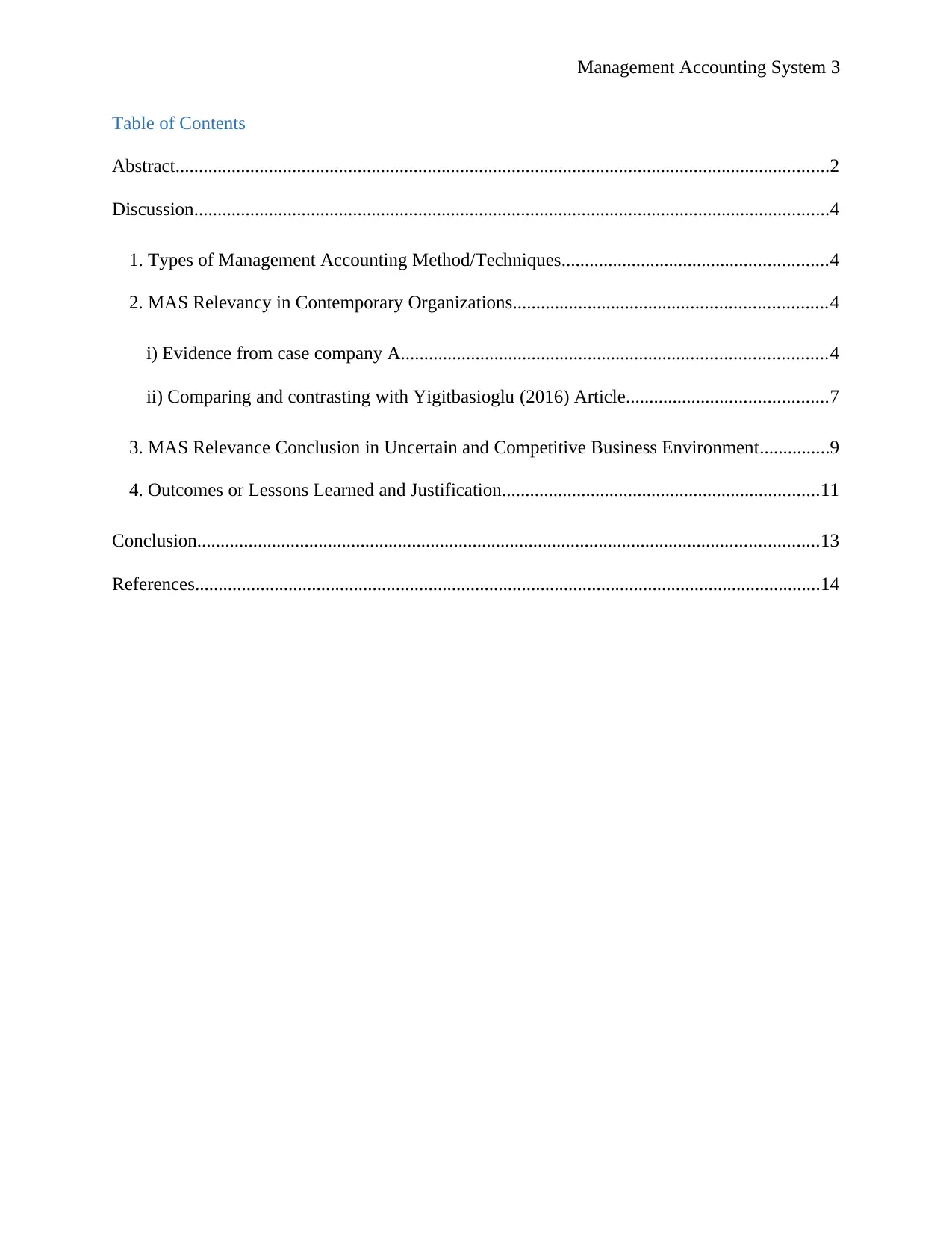
Management Accounting System 3
Table of Contents
Abstract............................................................................................................................................2
Discussion........................................................................................................................................4
1. Types of Management Accounting Method/Techniques.........................................................4
2. MAS Relevancy in Contemporary Organizations...................................................................4
i) Evidence from case company A...........................................................................................4
ii) Comparing and contrasting with Yigitbasioglu (2016) Article...........................................7
3. MAS Relevance Conclusion in Uncertain and Competitive Business Environment...............9
4. Outcomes or Lessons Learned and Justification....................................................................11
Conclusion.....................................................................................................................................13
References......................................................................................................................................14
Table of Contents
Abstract............................................................................................................................................2
Discussion........................................................................................................................................4
1. Types of Management Accounting Method/Techniques.........................................................4
2. MAS Relevancy in Contemporary Organizations...................................................................4
i) Evidence from case company A...........................................................................................4
ii) Comparing and contrasting with Yigitbasioglu (2016) Article...........................................7
3. MAS Relevance Conclusion in Uncertain and Competitive Business Environment...............9
4. Outcomes or Lessons Learned and Justification....................................................................11
Conclusion.....................................................................................................................................13
References......................................................................................................................................14
⊘ This is a preview!⊘
Do you want full access?
Subscribe today to unlock all pages.

Trusted by 1+ million students worldwide
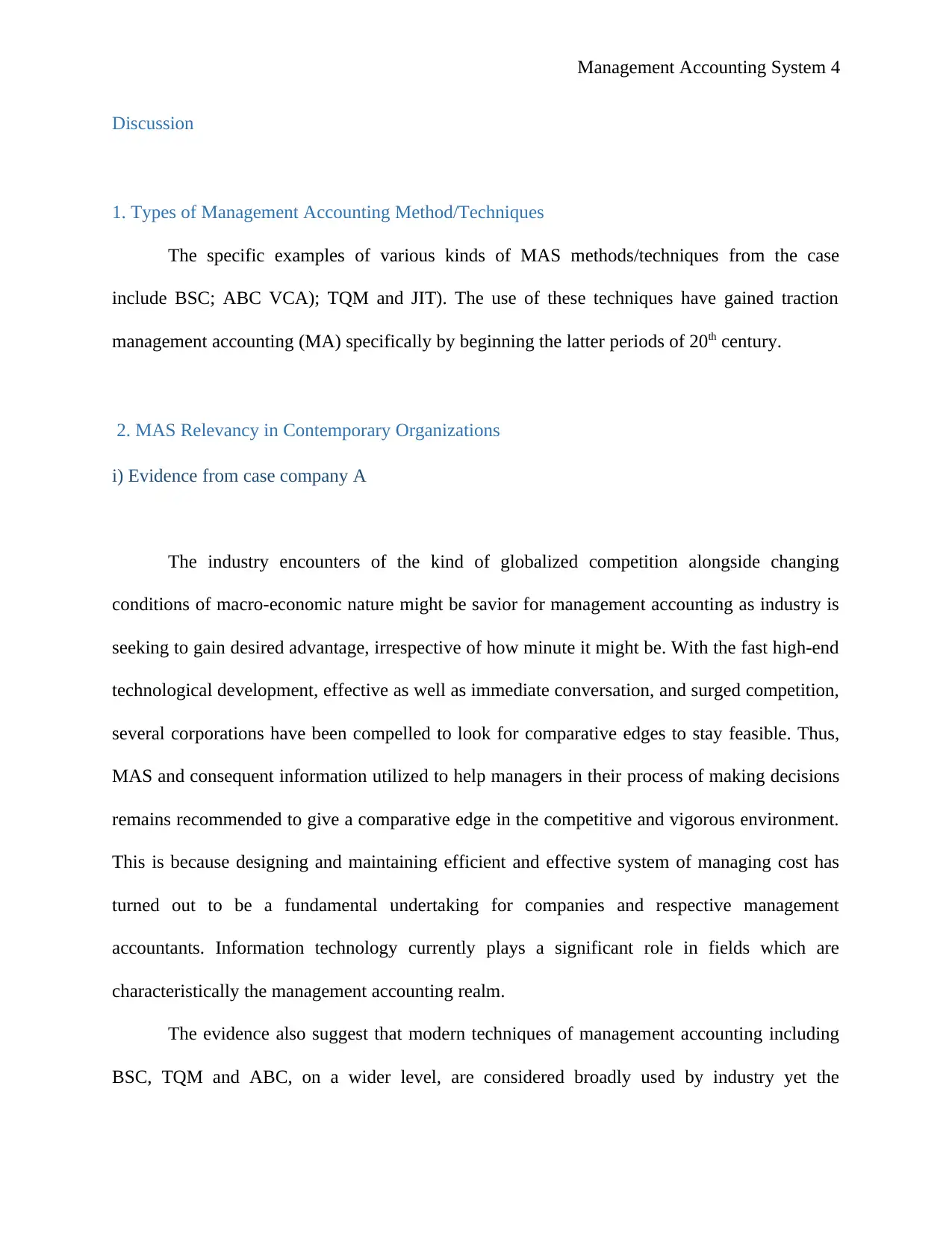
Management Accounting System 4
Discussion
1. Types of Management Accounting Method/Techniques
The specific examples of various kinds of MAS methods/techniques from the case
include BSC; ABC VCA); TQM and JIT). The use of these techniques have gained traction
management accounting (MA) specifically by beginning the latter periods of 20th century.
2. MAS Relevancy in Contemporary Organizations
i) Evidence from case company A
The industry encounters of the kind of globalized competition alongside changing
conditions of macro-economic nature might be savior for management accounting as industry is
seeking to gain desired advantage, irrespective of how minute it might be. With the fast high-end
technological development, effective as well as immediate conversation, and surged competition,
several corporations have been compelled to look for comparative edges to stay feasible. Thus,
MAS and consequent information utilized to help managers in their process of making decisions
remains recommended to give a comparative edge in the competitive and vigorous environment.
This is because designing and maintaining efficient and effective system of managing cost has
turned out to be a fundamental undertaking for companies and respective management
accountants. Information technology currently plays a significant role in fields which are
characteristically the management accounting realm.
The evidence also suggest that modern techniques of management accounting including
BSC, TQM and ABC, on a wider level, are considered broadly used by industry yet the
Discussion
1. Types of Management Accounting Method/Techniques
The specific examples of various kinds of MAS methods/techniques from the case
include BSC; ABC VCA); TQM and JIT). The use of these techniques have gained traction
management accounting (MA) specifically by beginning the latter periods of 20th century.
2. MAS Relevancy in Contemporary Organizations
i) Evidence from case company A
The industry encounters of the kind of globalized competition alongside changing
conditions of macro-economic nature might be savior for management accounting as industry is
seeking to gain desired advantage, irrespective of how minute it might be. With the fast high-end
technological development, effective as well as immediate conversation, and surged competition,
several corporations have been compelled to look for comparative edges to stay feasible. Thus,
MAS and consequent information utilized to help managers in their process of making decisions
remains recommended to give a comparative edge in the competitive and vigorous environment.
This is because designing and maintaining efficient and effective system of managing cost has
turned out to be a fundamental undertaking for companies and respective management
accountants. Information technology currently plays a significant role in fields which are
characteristically the management accounting realm.
The evidence also suggest that modern techniques of management accounting including
BSC, TQM and ABC, on a wider level, are considered broadly used by industry yet the
Paraphrase This Document
Need a fresh take? Get an instant paraphrase of this document with our AI Paraphraser
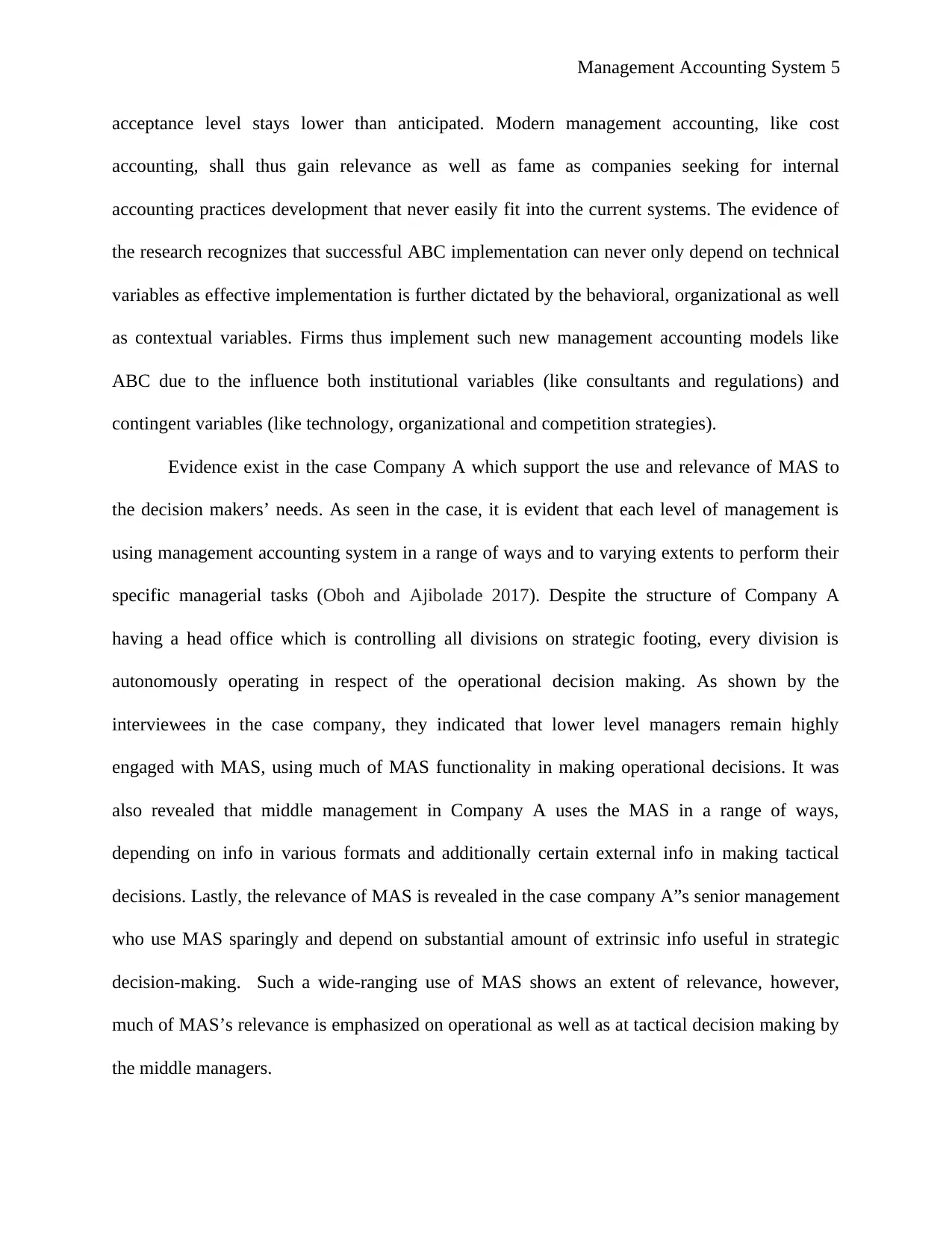
Management Accounting System 5
acceptance level stays lower than anticipated. Modern management accounting, like cost
accounting, shall thus gain relevance as well as fame as companies seeking for internal
accounting practices development that never easily fit into the current systems. The evidence of
the research recognizes that successful ABC implementation can never only depend on technical
variables as effective implementation is further dictated by the behavioral, organizational as well
as contextual variables. Firms thus implement such new management accounting models like
ABC due to the influence both institutional variables (like consultants and regulations) and
contingent variables (like technology, organizational and competition strategies).
Evidence exist in the case Company A which support the use and relevance of MAS to
the decision makers’ needs. As seen in the case, it is evident that each level of management is
using management accounting system in a range of ways and to varying extents to perform their
specific managerial tasks (Oboh and Ajibolade 2017). Despite the structure of Company A
having a head office which is controlling all divisions on strategic footing, every division is
autonomously operating in respect of the operational decision making. As shown by the
interviewees in the case company, they indicated that lower level managers remain highly
engaged with MAS, using much of MAS functionality in making operational decisions. It was
also revealed that middle management in Company A uses the MAS in a range of ways,
depending on info in various formats and additionally certain external info in making tactical
decisions. Lastly, the relevance of MAS is revealed in the case company A”s senior management
who use MAS sparingly and depend on substantial amount of extrinsic info useful in strategic
decision-making. Such a wide-ranging use of MAS shows an extent of relevance, however,
much of MAS’s relevance is emphasized on operational as well as at tactical decision making by
the middle managers.
acceptance level stays lower than anticipated. Modern management accounting, like cost
accounting, shall thus gain relevance as well as fame as companies seeking for internal
accounting practices development that never easily fit into the current systems. The evidence of
the research recognizes that successful ABC implementation can never only depend on technical
variables as effective implementation is further dictated by the behavioral, organizational as well
as contextual variables. Firms thus implement such new management accounting models like
ABC due to the influence both institutional variables (like consultants and regulations) and
contingent variables (like technology, organizational and competition strategies).
Evidence exist in the case Company A which support the use and relevance of MAS to
the decision makers’ needs. As seen in the case, it is evident that each level of management is
using management accounting system in a range of ways and to varying extents to perform their
specific managerial tasks (Oboh and Ajibolade 2017). Despite the structure of Company A
having a head office which is controlling all divisions on strategic footing, every division is
autonomously operating in respect of the operational decision making. As shown by the
interviewees in the case company, they indicated that lower level managers remain highly
engaged with MAS, using much of MAS functionality in making operational decisions. It was
also revealed that middle management in Company A uses the MAS in a range of ways,
depending on info in various formats and additionally certain external info in making tactical
decisions. Lastly, the relevance of MAS is revealed in the case company A”s senior management
who use MAS sparingly and depend on substantial amount of extrinsic info useful in strategic
decision-making. Such a wide-ranging use of MAS shows an extent of relevance, however,
much of MAS’s relevance is emphasized on operational as well as at tactical decision making by
the middle managers.
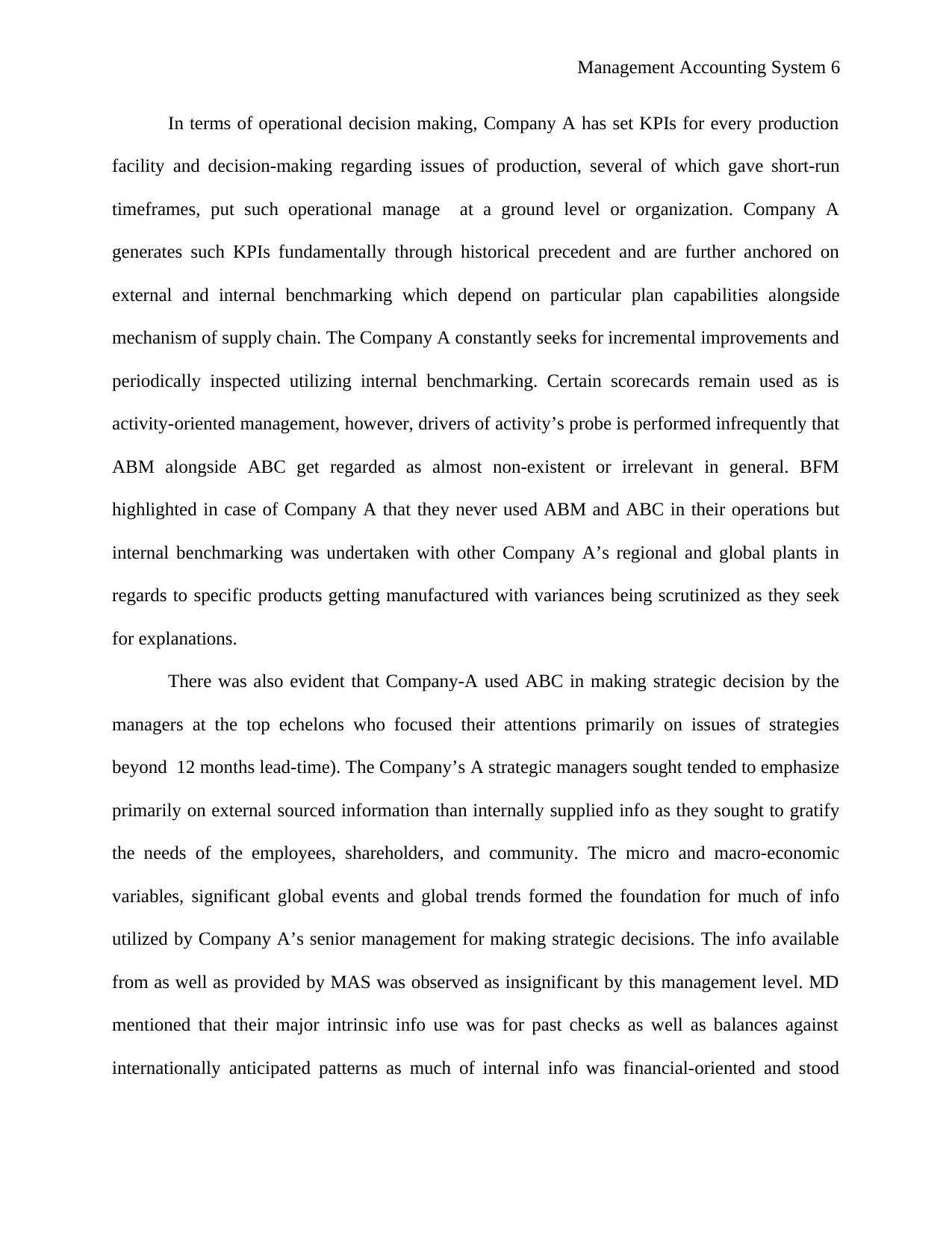
Management Accounting System 6
In terms of operational decision making, Company A has set KPIs for every production
facility and decision-making regarding issues of production, several of which gave short-run
timeframes, put such operational manage at a ground level or organization. Company A
generates such KPIs fundamentally through historical precedent and are further anchored on
external and internal benchmarking which depend on particular plan capabilities alongside
mechanism of supply chain. The Company A constantly seeks for incremental improvements and
periodically inspected utilizing internal benchmarking. Certain scorecards remain used as is
activity-oriented management, however, drivers of activity’s probe is performed infrequently that
ABM alongside ABC get regarded as almost non-existent or irrelevant in general. BFM
highlighted in case of Company A that they never used ABM and ABC in their operations but
internal benchmarking was undertaken with other Company A’s regional and global plants in
regards to specific products getting manufactured with variances being scrutinized as they seek
for explanations.
There was also evident that Company-A used ABC in making strategic decision by the
managers at the top echelons who focused their attentions primarily on issues of strategies
beyond 12 months lead-time). The Company’s A strategic managers sought tended to emphasize
primarily on external sourced information than internally supplied info as they sought to gratify
the needs of the employees, shareholders, and community. The micro and macro-economic
variables, significant global events and global trends formed the foundation for much of info
utilized by Company A’s senior management for making strategic decisions. The info available
from as well as provided by MAS was observed as insignificant by this management level. MD
mentioned that their major intrinsic info use was for past checks as well as balances against
internationally anticipated patterns as much of internal info was financial-oriented and stood
In terms of operational decision making, Company A has set KPIs for every production
facility and decision-making regarding issues of production, several of which gave short-run
timeframes, put such operational manage at a ground level or organization. Company A
generates such KPIs fundamentally through historical precedent and are further anchored on
external and internal benchmarking which depend on particular plan capabilities alongside
mechanism of supply chain. The Company A constantly seeks for incremental improvements and
periodically inspected utilizing internal benchmarking. Certain scorecards remain used as is
activity-oriented management, however, drivers of activity’s probe is performed infrequently that
ABM alongside ABC get regarded as almost non-existent or irrelevant in general. BFM
highlighted in case of Company A that they never used ABM and ABC in their operations but
internal benchmarking was undertaken with other Company A’s regional and global plants in
regards to specific products getting manufactured with variances being scrutinized as they seek
for explanations.
There was also evident that Company-A used ABC in making strategic decision by the
managers at the top echelons who focused their attentions primarily on issues of strategies
beyond 12 months lead-time). The Company’s A strategic managers sought tended to emphasize
primarily on external sourced information than internally supplied info as they sought to gratify
the needs of the employees, shareholders, and community. The micro and macro-economic
variables, significant global events and global trends formed the foundation for much of info
utilized by Company A’s senior management for making strategic decisions. The info available
from as well as provided by MAS was observed as insignificant by this management level. MD
mentioned that their major intrinsic info use was for past checks as well as balances against
internationally anticipated patterns as much of internal info was financial-oriented and stood
⊘ This is a preview!⊘
Do you want full access?
Subscribe today to unlock all pages.

Trusted by 1+ million students worldwide
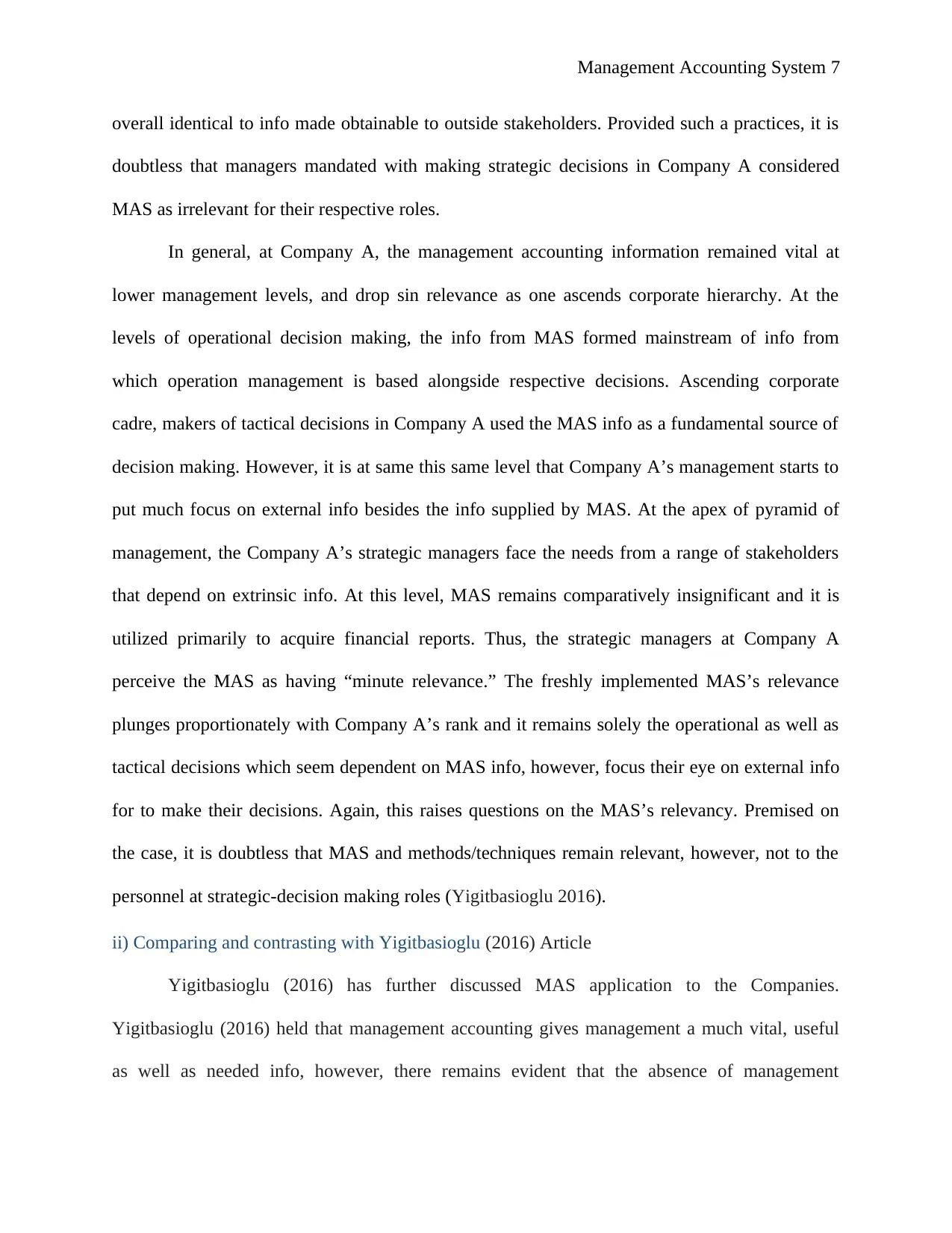
Management Accounting System 7
overall identical to info made obtainable to outside stakeholders. Provided such a practices, it is
doubtless that managers mandated with making strategic decisions in Company A considered
MAS as irrelevant for their respective roles.
In general, at Company A, the management accounting information remained vital at
lower management levels, and drop sin relevance as one ascends corporate hierarchy. At the
levels of operational decision making, the info from MAS formed mainstream of info from
which operation management is based alongside respective decisions. Ascending corporate
cadre, makers of tactical decisions in Company A used the MAS info as a fundamental source of
decision making. However, it is at same this same level that Company A’s management starts to
put much focus on external info besides the info supplied by MAS. At the apex of pyramid of
management, the Company A’s strategic managers face the needs from a range of stakeholders
that depend on extrinsic info. At this level, MAS remains comparatively insignificant and it is
utilized primarily to acquire financial reports. Thus, the strategic managers at Company A
perceive the MAS as having “minute relevance.” The freshly implemented MAS’s relevance
plunges proportionately with Company A’s rank and it remains solely the operational as well as
tactical decisions which seem dependent on MAS info, however, focus their eye on external info
for to make their decisions. Again, this raises questions on the MAS’s relevancy. Premised on
the case, it is doubtless that MAS and methods/techniques remain relevant, however, not to the
personnel at strategic-decision making roles (Yigitbasioglu 2016).
ii) Comparing and contrasting with Yigitbasioglu (2016) Article
Yigitbasioglu (2016) has further discussed MAS application to the Companies.
Yigitbasioglu (2016) held that management accounting gives management a much vital, useful
as well as needed info, however, there remains evident that the absence of management
overall identical to info made obtainable to outside stakeholders. Provided such a practices, it is
doubtless that managers mandated with making strategic decisions in Company A considered
MAS as irrelevant for their respective roles.
In general, at Company A, the management accounting information remained vital at
lower management levels, and drop sin relevance as one ascends corporate hierarchy. At the
levels of operational decision making, the info from MAS formed mainstream of info from
which operation management is based alongside respective decisions. Ascending corporate
cadre, makers of tactical decisions in Company A used the MAS info as a fundamental source of
decision making. However, it is at same this same level that Company A’s management starts to
put much focus on external info besides the info supplied by MAS. At the apex of pyramid of
management, the Company A’s strategic managers face the needs from a range of stakeholders
that depend on extrinsic info. At this level, MAS remains comparatively insignificant and it is
utilized primarily to acquire financial reports. Thus, the strategic managers at Company A
perceive the MAS as having “minute relevance.” The freshly implemented MAS’s relevance
plunges proportionately with Company A’s rank and it remains solely the operational as well as
tactical decisions which seem dependent on MAS info, however, focus their eye on external info
for to make their decisions. Again, this raises questions on the MAS’s relevancy. Premised on
the case, it is doubtless that MAS and methods/techniques remain relevant, however, not to the
personnel at strategic-decision making roles (Yigitbasioglu 2016).
ii) Comparing and contrasting with Yigitbasioglu (2016) Article
Yigitbasioglu (2016) has further discussed MAS application to the Companies.
Yigitbasioglu (2016) held that management accounting gives management a much vital, useful
as well as needed info, however, there remains evident that the absence of management
Paraphrase This Document
Need a fresh take? Get an instant paraphrase of this document with our AI Paraphraser
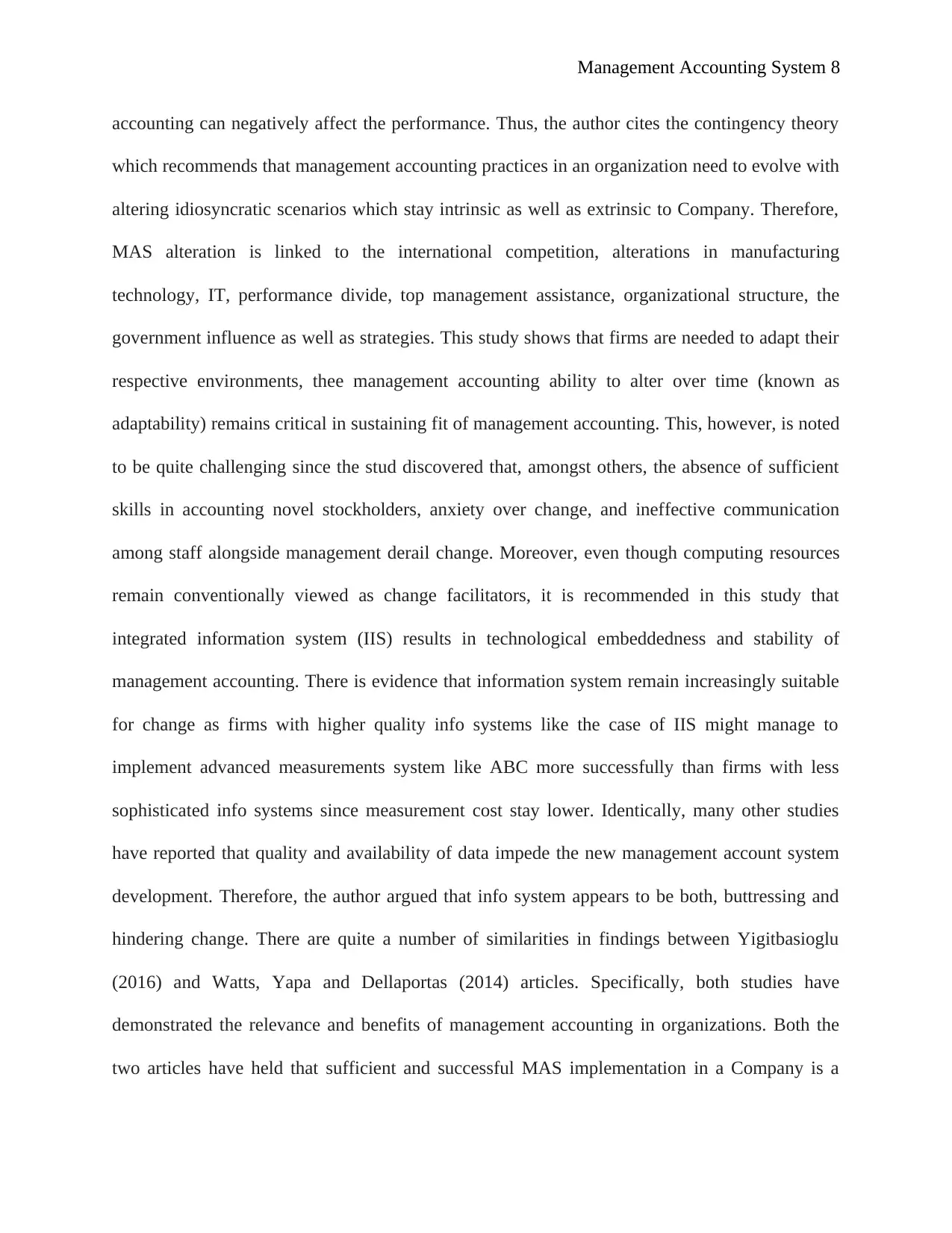
Management Accounting System 8
accounting can negatively affect the performance. Thus, the author cites the contingency theory
which recommends that management accounting practices in an organization need to evolve with
altering idiosyncratic scenarios which stay intrinsic as well as extrinsic to Company. Therefore,
MAS alteration is linked to the international competition, alterations in manufacturing
technology, IT, performance divide, top management assistance, organizational structure, the
government influence as well as strategies. This study shows that firms are needed to adapt their
respective environments, thee management accounting ability to alter over time (known as
adaptability) remains critical in sustaining fit of management accounting. This, however, is noted
to be quite challenging since the stud discovered that, amongst others, the absence of sufficient
skills in accounting novel stockholders, anxiety over change, and ineffective communication
among staff alongside management derail change. Moreover, even though computing resources
remain conventionally viewed as change facilitators, it is recommended in this study that
integrated information system (IIS) results in technological embeddedness and stability of
management accounting. There is evidence that information system remain increasingly suitable
for change as firms with higher quality info systems like the case of IIS might manage to
implement advanced measurements system like ABC more successfully than firms with less
sophisticated info systems since measurement cost stay lower. Identically, many other studies
have reported that quality and availability of data impede the new management account system
development. Therefore, the author argued that info system appears to be both, buttressing and
hindering change. There are quite a number of similarities in findings between Yigitbasioglu
(2016) and Watts, Yapa and Dellaportas (2014) articles. Specifically, both studies have
demonstrated the relevance and benefits of management accounting in organizations. Both the
two articles have held that sufficient and successful MAS implementation in a Company is a
accounting can negatively affect the performance. Thus, the author cites the contingency theory
which recommends that management accounting practices in an organization need to evolve with
altering idiosyncratic scenarios which stay intrinsic as well as extrinsic to Company. Therefore,
MAS alteration is linked to the international competition, alterations in manufacturing
technology, IT, performance divide, top management assistance, organizational structure, the
government influence as well as strategies. This study shows that firms are needed to adapt their
respective environments, thee management accounting ability to alter over time (known as
adaptability) remains critical in sustaining fit of management accounting. This, however, is noted
to be quite challenging since the stud discovered that, amongst others, the absence of sufficient
skills in accounting novel stockholders, anxiety over change, and ineffective communication
among staff alongside management derail change. Moreover, even though computing resources
remain conventionally viewed as change facilitators, it is recommended in this study that
integrated information system (IIS) results in technological embeddedness and stability of
management accounting. There is evidence that information system remain increasingly suitable
for change as firms with higher quality info systems like the case of IIS might manage to
implement advanced measurements system like ABC more successfully than firms with less
sophisticated info systems since measurement cost stay lower. Identically, many other studies
have reported that quality and availability of data impede the new management account system
development. Therefore, the author argued that info system appears to be both, buttressing and
hindering change. There are quite a number of similarities in findings between Yigitbasioglu
(2016) and Watts, Yapa and Dellaportas (2014) articles. Specifically, both studies have
demonstrated the relevance and benefits of management accounting in organizations. Both the
two articles have held that sufficient and successful MAS implementation in a Company is a
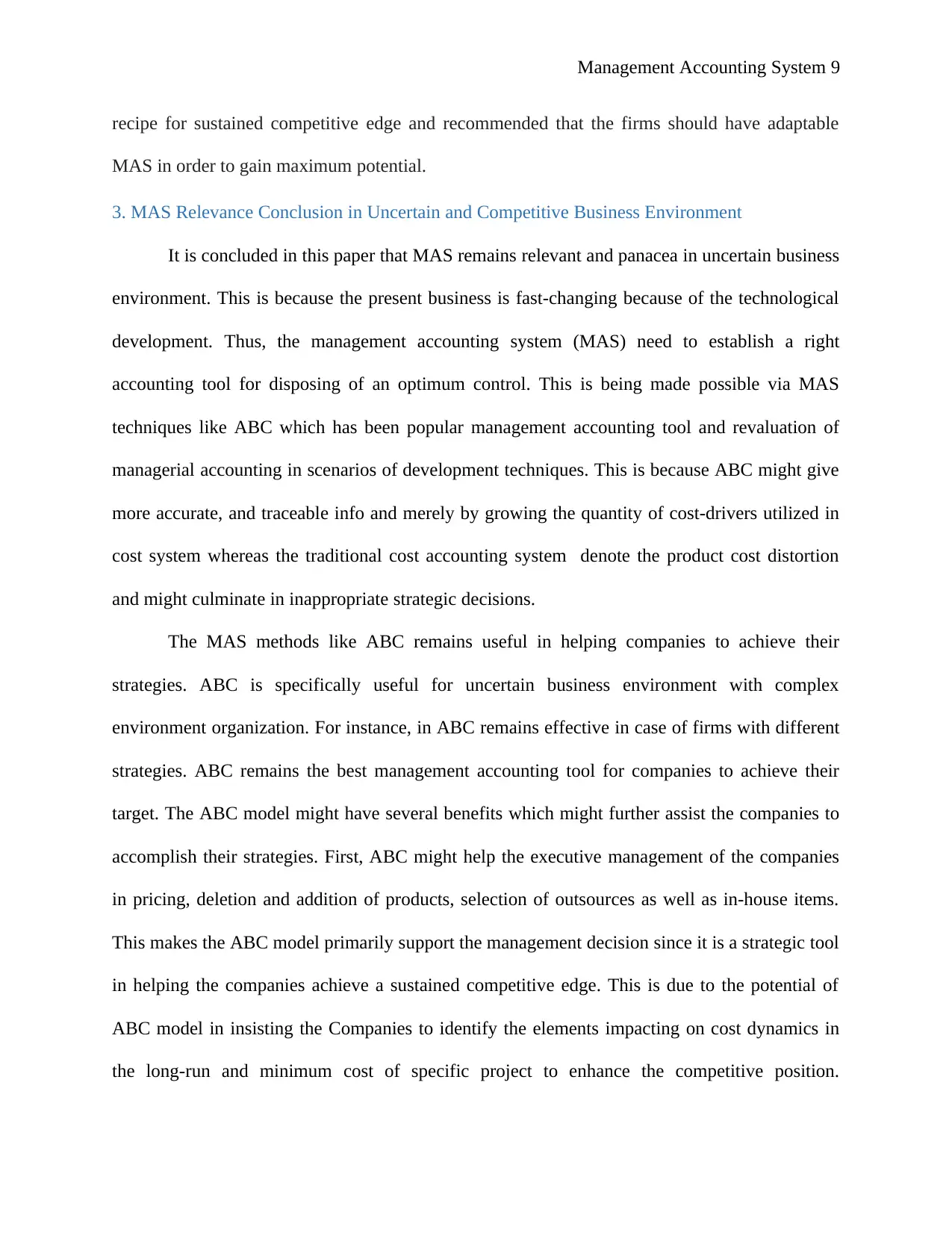
Management Accounting System 9
recipe for sustained competitive edge and recommended that the firms should have adaptable
MAS in order to gain maximum potential.
3. MAS Relevance Conclusion in Uncertain and Competitive Business Environment
It is concluded in this paper that MAS remains relevant and panacea in uncertain business
environment. This is because the present business is fast-changing because of the technological
development. Thus, the management accounting system (MAS) need to establish a right
accounting tool for disposing of an optimum control. This is being made possible via MAS
techniques like ABC which has been popular management accounting tool and revaluation of
managerial accounting in scenarios of development techniques. This is because ABC might give
more accurate, and traceable info and merely by growing the quantity of cost-drivers utilized in
cost system whereas the traditional cost accounting system denote the product cost distortion
and might culminate in inappropriate strategic decisions.
The MAS methods like ABC remains useful in helping companies to achieve their
strategies. ABC is specifically useful for uncertain business environment with complex
environment organization. For instance, in ABC remains effective in case of firms with different
strategies. ABC remains the best management accounting tool for companies to achieve their
target. The ABC model might have several benefits which might further assist the companies to
accomplish their strategies. First, ABC might help the executive management of the companies
in pricing, deletion and addition of products, selection of outsources as well as in-house items.
This makes the ABC model primarily support the management decision since it is a strategic tool
in helping the companies achieve a sustained competitive edge. This is due to the potential of
ABC model in insisting the Companies to identify the elements impacting on cost dynamics in
the long-run and minimum cost of specific project to enhance the competitive position.
recipe for sustained competitive edge and recommended that the firms should have adaptable
MAS in order to gain maximum potential.
3. MAS Relevance Conclusion in Uncertain and Competitive Business Environment
It is concluded in this paper that MAS remains relevant and panacea in uncertain business
environment. This is because the present business is fast-changing because of the technological
development. Thus, the management accounting system (MAS) need to establish a right
accounting tool for disposing of an optimum control. This is being made possible via MAS
techniques like ABC which has been popular management accounting tool and revaluation of
managerial accounting in scenarios of development techniques. This is because ABC might give
more accurate, and traceable info and merely by growing the quantity of cost-drivers utilized in
cost system whereas the traditional cost accounting system denote the product cost distortion
and might culminate in inappropriate strategic decisions.
The MAS methods like ABC remains useful in helping companies to achieve their
strategies. ABC is specifically useful for uncertain business environment with complex
environment organization. For instance, in ABC remains effective in case of firms with different
strategies. ABC remains the best management accounting tool for companies to achieve their
target. The ABC model might have several benefits which might further assist the companies to
accomplish their strategies. First, ABC might help the executive management of the companies
in pricing, deletion and addition of products, selection of outsources as well as in-house items.
This makes the ABC model primarily support the management decision since it is a strategic tool
in helping the companies achieve a sustained competitive edge. This is due to the potential of
ABC model in insisting the Companies to identify the elements impacting on cost dynamics in
the long-run and minimum cost of specific project to enhance the competitive position.
⊘ This is a preview!⊘
Do you want full access?
Subscribe today to unlock all pages.

Trusted by 1+ million students worldwide
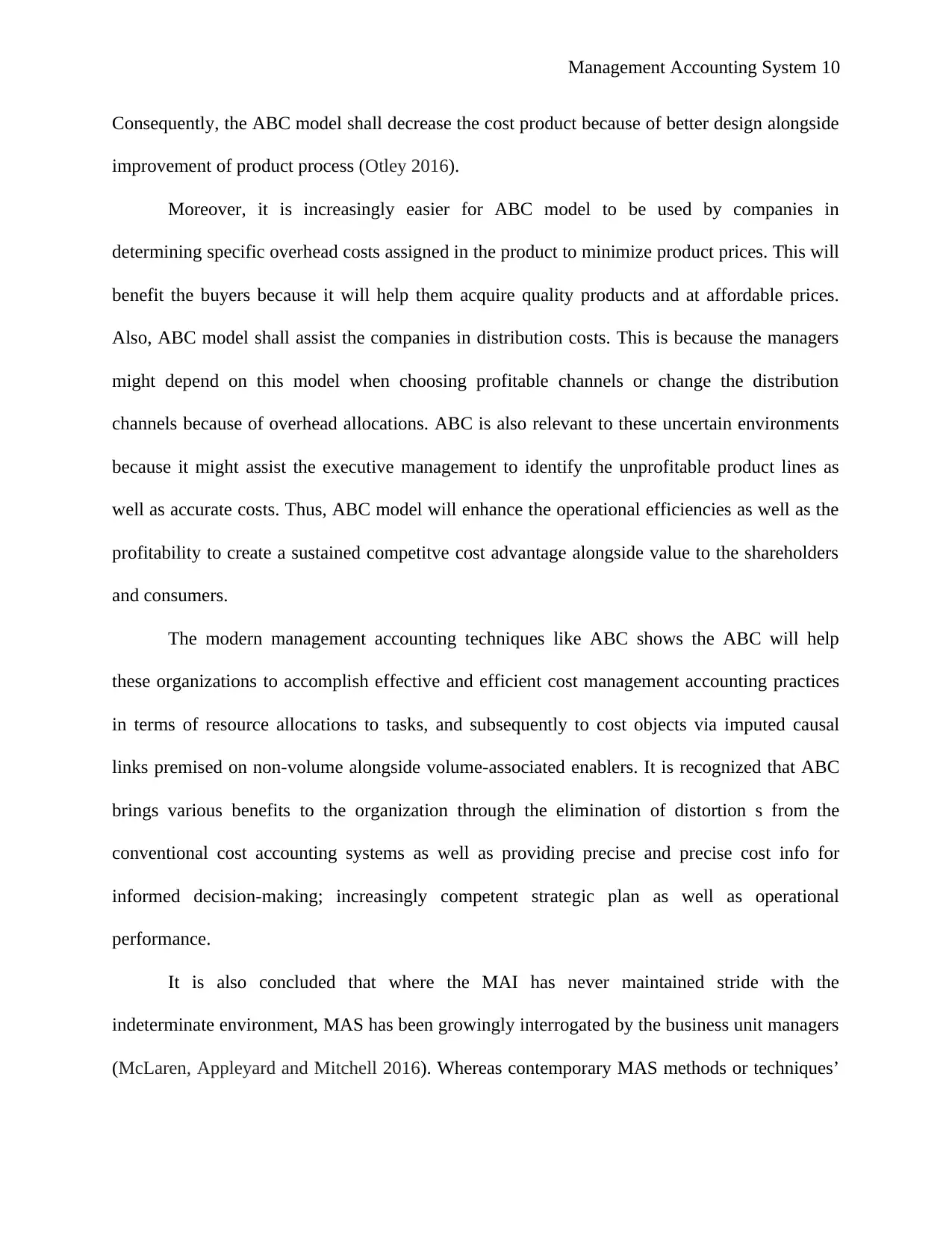
Management Accounting System 10
Consequently, the ABC model shall decrease the cost product because of better design alongside
improvement of product process (Otley 2016).
Moreover, it is increasingly easier for ABC model to be used by companies in
determining specific overhead costs assigned in the product to minimize product prices. This will
benefit the buyers because it will help them acquire quality products and at affordable prices.
Also, ABC model shall assist the companies in distribution costs. This is because the managers
might depend on this model when choosing profitable channels or change the distribution
channels because of overhead allocations. ABC is also relevant to these uncertain environments
because it might assist the executive management to identify the unprofitable product lines as
well as accurate costs. Thus, ABC model will enhance the operational efficiencies as well as the
profitability to create a sustained competitve cost advantage alongside value to the shareholders
and consumers.
The modern management accounting techniques like ABC shows the ABC will help
these organizations to accomplish effective and efficient cost management accounting practices
in terms of resource allocations to tasks, and subsequently to cost objects via imputed causal
links premised on non-volume alongside volume-associated enablers. It is recognized that ABC
brings various benefits to the organization through the elimination of distortion s from the
conventional cost accounting systems as well as providing precise and precise cost info for
informed decision-making; increasingly competent strategic plan as well as operational
performance.
It is also concluded that where the MAI has never maintained stride with the
indeterminate environment, MAS has been growingly interrogated by the business unit managers
(McLaren, Appleyard and Mitchell 2016). Whereas contemporary MAS methods or techniques’
Consequently, the ABC model shall decrease the cost product because of better design alongside
improvement of product process (Otley 2016).
Moreover, it is increasingly easier for ABC model to be used by companies in
determining specific overhead costs assigned in the product to minimize product prices. This will
benefit the buyers because it will help them acquire quality products and at affordable prices.
Also, ABC model shall assist the companies in distribution costs. This is because the managers
might depend on this model when choosing profitable channels or change the distribution
channels because of overhead allocations. ABC is also relevant to these uncertain environments
because it might assist the executive management to identify the unprofitable product lines as
well as accurate costs. Thus, ABC model will enhance the operational efficiencies as well as the
profitability to create a sustained competitve cost advantage alongside value to the shareholders
and consumers.
The modern management accounting techniques like ABC shows the ABC will help
these organizations to accomplish effective and efficient cost management accounting practices
in terms of resource allocations to tasks, and subsequently to cost objects via imputed causal
links premised on non-volume alongside volume-associated enablers. It is recognized that ABC
brings various benefits to the organization through the elimination of distortion s from the
conventional cost accounting systems as well as providing precise and precise cost info for
informed decision-making; increasingly competent strategic plan as well as operational
performance.
It is also concluded that where the MAI has never maintained stride with the
indeterminate environment, MAS has been growingly interrogated by the business unit managers
(McLaren, Appleyard and Mitchell 2016). Whereas contemporary MAS methods or techniques’
Paraphrase This Document
Need a fresh take? Get an instant paraphrase of this document with our AI Paraphraser
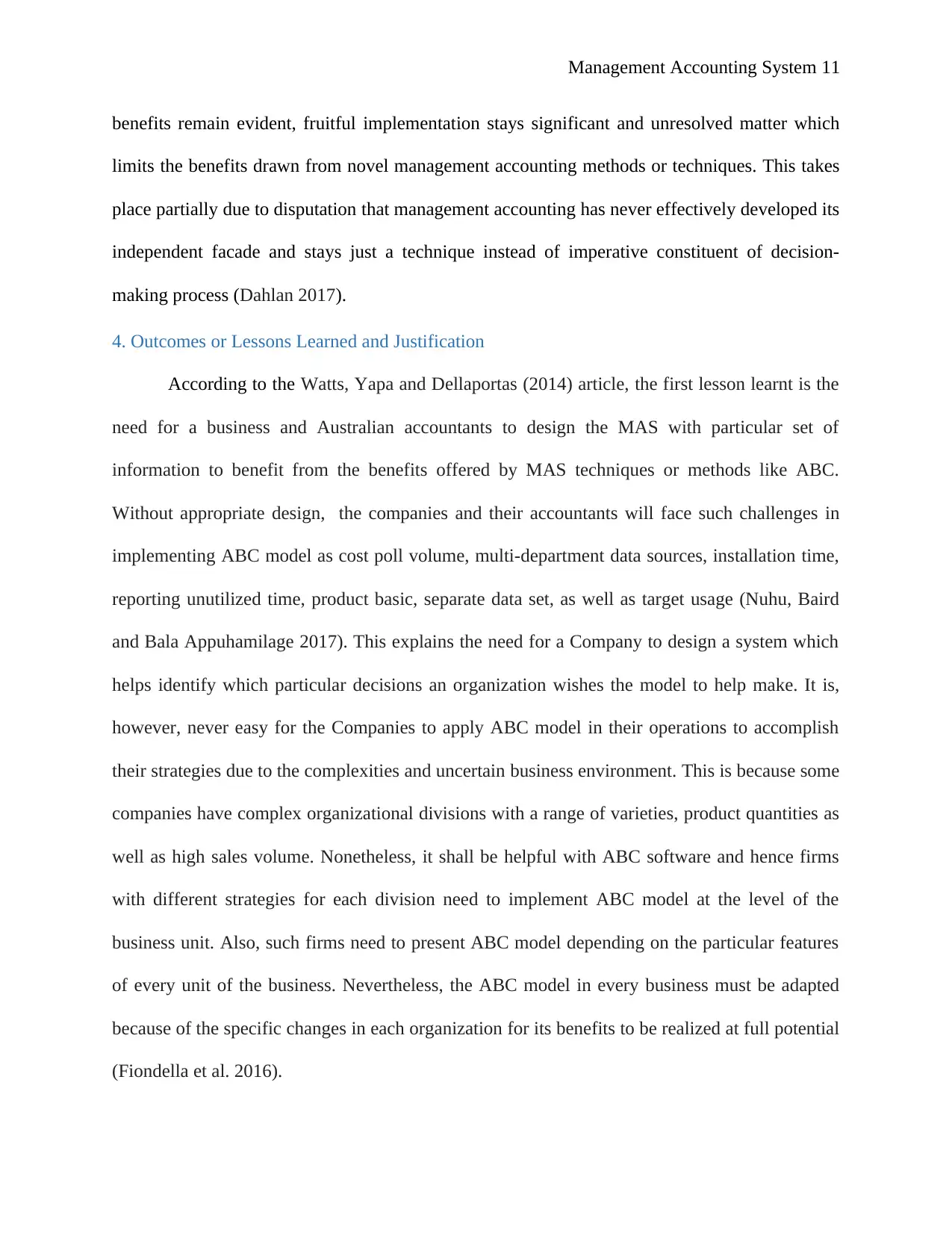
Management Accounting System 11
benefits remain evident, fruitful implementation stays significant and unresolved matter which
limits the benefits drawn from novel management accounting methods or techniques. This takes
place partially due to disputation that management accounting has never effectively developed its
independent facade and stays just a technique instead of imperative constituent of decision-
making process (Dahlan 2017).
4. Outcomes or Lessons Learned and Justification
According to the Watts, Yapa and Dellaportas (2014) article, the first lesson learnt is the
need for a business and Australian accountants to design the MAS with particular set of
information to benefit from the benefits offered by MAS techniques or methods like ABC.
Without appropriate design, the companies and their accountants will face such challenges in
implementing ABC model as cost poll volume, multi-department data sources, installation time,
reporting unutilized time, product basic, separate data set, as well as target usage (Nuhu, Baird
and Bala Appuhamilage 2017). This explains the need for a Company to design a system which
helps identify which particular decisions an organization wishes the model to help make. It is,
however, never easy for the Companies to apply ABC model in their operations to accomplish
their strategies due to the complexities and uncertain business environment. This is because some
companies have complex organizational divisions with a range of varieties, product quantities as
well as high sales volume. Nonetheless, it shall be helpful with ABC software and hence firms
with different strategies for each division need to implement ABC model at the level of the
business unit. Also, such firms need to present ABC model depending on the particular features
of every unit of the business. Nevertheless, the ABC model in every business must be adapted
because of the specific changes in each organization for its benefits to be realized at full potential
(Fiondella et al. 2016).
benefits remain evident, fruitful implementation stays significant and unresolved matter which
limits the benefits drawn from novel management accounting methods or techniques. This takes
place partially due to disputation that management accounting has never effectively developed its
independent facade and stays just a technique instead of imperative constituent of decision-
making process (Dahlan 2017).
4. Outcomes or Lessons Learned and Justification
According to the Watts, Yapa and Dellaportas (2014) article, the first lesson learnt is the
need for a business and Australian accountants to design the MAS with particular set of
information to benefit from the benefits offered by MAS techniques or methods like ABC.
Without appropriate design, the companies and their accountants will face such challenges in
implementing ABC model as cost poll volume, multi-department data sources, installation time,
reporting unutilized time, product basic, separate data set, as well as target usage (Nuhu, Baird
and Bala Appuhamilage 2017). This explains the need for a Company to design a system which
helps identify which particular decisions an organization wishes the model to help make. It is,
however, never easy for the Companies to apply ABC model in their operations to accomplish
their strategies due to the complexities and uncertain business environment. This is because some
companies have complex organizational divisions with a range of varieties, product quantities as
well as high sales volume. Nonetheless, it shall be helpful with ABC software and hence firms
with different strategies for each division need to implement ABC model at the level of the
business unit. Also, such firms need to present ABC model depending on the particular features
of every unit of the business. Nevertheless, the ABC model in every business must be adapted
because of the specific changes in each organization for its benefits to be realized at full potential
(Fiondella et al. 2016).
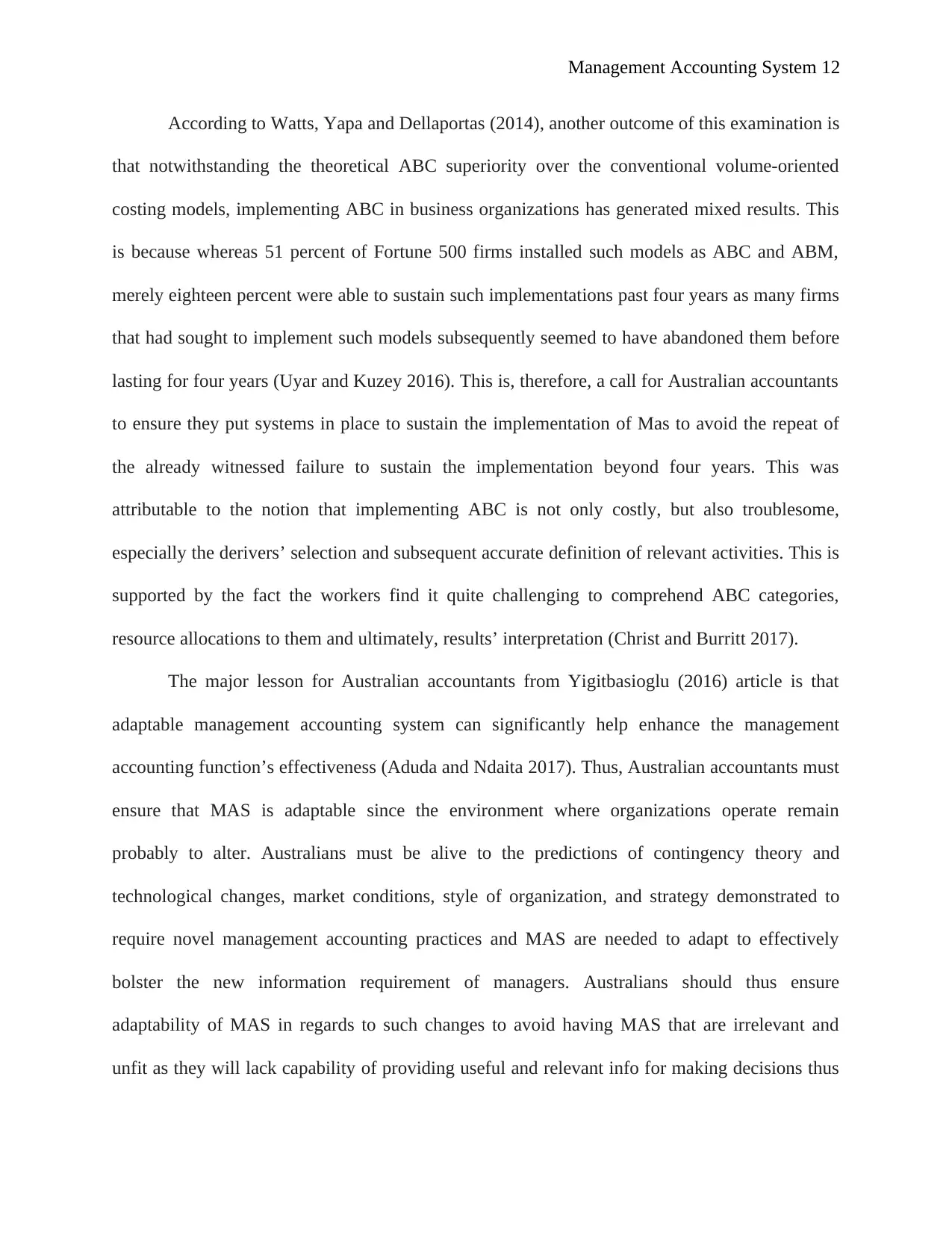
Management Accounting System 12
According to Watts, Yapa and Dellaportas (2014), another outcome of this examination is
that notwithstanding the theoretical ABC superiority over the conventional volume-oriented
costing models, implementing ABC in business organizations has generated mixed results. This
is because whereas 51 percent of Fortune 500 firms installed such models as ABC and ABM,
merely eighteen percent were able to sustain such implementations past four years as many firms
that had sought to implement such models subsequently seemed to have abandoned them before
lasting for four years (Uyar and Kuzey 2016). This is, therefore, a call for Australian accountants
to ensure they put systems in place to sustain the implementation of Mas to avoid the repeat of
the already witnessed failure to sustain the implementation beyond four years. This was
attributable to the notion that implementing ABC is not only costly, but also troublesome,
especially the derivers’ selection and subsequent accurate definition of relevant activities. This is
supported by the fact the workers find it quite challenging to comprehend ABC categories,
resource allocations to them and ultimately, results’ interpretation (Christ and Burritt 2017).
The major lesson for Australian accountants from Yigitbasioglu (2016) article is that
adaptable management accounting system can significantly help enhance the management
accounting function’s effectiveness (Aduda and Ndaita 2017). Thus, Australian accountants must
ensure that MAS is adaptable since the environment where organizations operate remain
probably to alter. Australians must be alive to the predictions of contingency theory and
technological changes, market conditions, style of organization, and strategy demonstrated to
require novel management accounting practices and MAS are needed to adapt to effectively
bolster the new information requirement of managers. Australians should thus ensure
adaptability of MAS in regards to such changes to avoid having MAS that are irrelevant and
unfit as they will lack capability of providing useful and relevant info for making decisions thus
According to Watts, Yapa and Dellaportas (2014), another outcome of this examination is
that notwithstanding the theoretical ABC superiority over the conventional volume-oriented
costing models, implementing ABC in business organizations has generated mixed results. This
is because whereas 51 percent of Fortune 500 firms installed such models as ABC and ABM,
merely eighteen percent were able to sustain such implementations past four years as many firms
that had sought to implement such models subsequently seemed to have abandoned them before
lasting for four years (Uyar and Kuzey 2016). This is, therefore, a call for Australian accountants
to ensure they put systems in place to sustain the implementation of Mas to avoid the repeat of
the already witnessed failure to sustain the implementation beyond four years. This was
attributable to the notion that implementing ABC is not only costly, but also troublesome,
especially the derivers’ selection and subsequent accurate definition of relevant activities. This is
supported by the fact the workers find it quite challenging to comprehend ABC categories,
resource allocations to them and ultimately, results’ interpretation (Christ and Burritt 2017).
The major lesson for Australian accountants from Yigitbasioglu (2016) article is that
adaptable management accounting system can significantly help enhance the management
accounting function’s effectiveness (Aduda and Ndaita 2017). Thus, Australian accountants must
ensure that MAS is adaptable since the environment where organizations operate remain
probably to alter. Australians must be alive to the predictions of contingency theory and
technological changes, market conditions, style of organization, and strategy demonstrated to
require novel management accounting practices and MAS are needed to adapt to effectively
bolster the new information requirement of managers. Australians should thus ensure
adaptability of MAS in regards to such changes to avoid having MAS that are irrelevant and
unfit as they will lack capability of providing useful and relevant info for making decisions thus
⊘ This is a preview!⊘
Do you want full access?
Subscribe today to unlock all pages.

Trusted by 1+ million students worldwide
1 out of 15
Related Documents
Your All-in-One AI-Powered Toolkit for Academic Success.
+13062052269
info@desklib.com
Available 24*7 on WhatsApp / Email
![[object Object]](/_next/static/media/star-bottom.7253800d.svg)
Unlock your academic potential
Copyright © 2020–2025 A2Z Services. All Rights Reserved. Developed and managed by ZUCOL.





